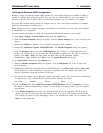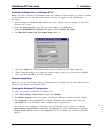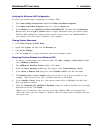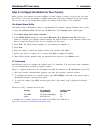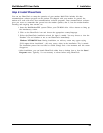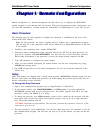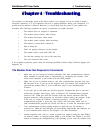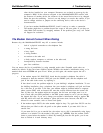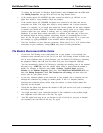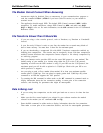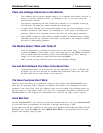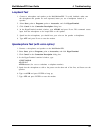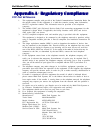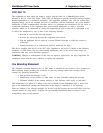
4 Troubleshooting
18
MultiModemZPX User Guide
other devices installed on your computer. Resources are assigned at power-up by the
computer’s BIOS. If the resources assigned to the MultiModemZPX-PCI conflict with
the resources of another device, the resources of the second device have to be changed.
Select the port the conflicting device is on and change it to resolve the conflict. If you
need to change switches or jumpers on the conflicting device, refer to the device’s
documentation.
• If you have another MultiModemZPX-PCI, install it and try to make a connection.
• The modem might have a problem beyond the scope of this user guide. If you have an
other Multi-Tech modem, try swapping modems. If the problem goes away, call Techni
cal Support for assistance.
The Modem Cannot Connect When Dialing
Reasons why the MultiModemZPX-PCI may fail to connect include:
• lack of a physical connection to the telephone line.
• a wrong dial tone.
• a busy signal.
• a wrong number.
• no modem at the other end.
• a faulty modem, computer, or software at the other end.
• incompatibility between modems
• poor line conditions.
You can narrow the list of possibilities by using extended result codes. Extended result codes are
enabled by default. If they have been disabled, include V1X4 in the modem’s initialization string, or in
terminal mode enter ATV1X4 and press E
NTER. When you dial again, the modem reports the call’s
progress.
• If the modem reports NO DIALTONE, check that the modem’s telephone line cable is
connected to both the modem’s LINE jack (not the PHONE jack) and the telephone wall
jack. If the cable looks secure, try replacing it.
If that doesn’t work, the problem might be in your building’s telephone installation. To test
the building installation, plug a telephone into your modem’s telephone wall jack and listen
for a dial tone. If you hear a dial tone, your modem might be installed behind a corporate
phone system (PBX) with an internal dial tone that sounds different from the normal dial
tone. In that case, the modem might not recognize the dial tone and might treat it as an
error. Check with your PBX personnel or the PBX system manual to see if you can change
the internal dial tone. If you can’t, change your modem’s initialization string to replace X4
with X3, which will cause the modem to ignore dial tones (note, however, that X3 is not
allowed in some countries, such as France and Spain).
• If the modem reports BUSY, the other number might be busy. Try again later. BUSY can also
indicate that you failed to add a 9, prefix to the phone number if you must dial 9 for an
outside line.
If you must dial 9 to get an outside line, the easiest way to dial it automatically using legacy
software is to include it in the modem’s dial prefix, e.g., ATDT9,. Note the comma, which
inserts a pause before the number is dialed. By inserting 9, into the dial prefix, you do not
have to include it in each directory entry.



